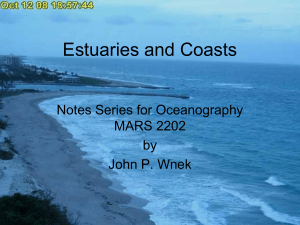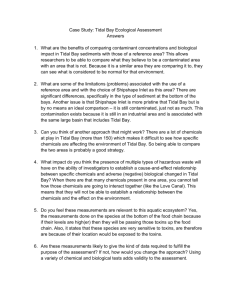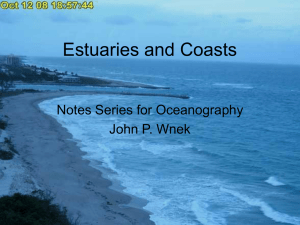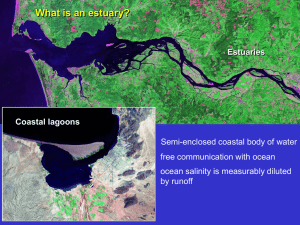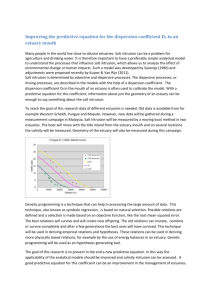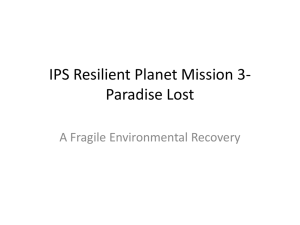Sample Student Report
advertisement
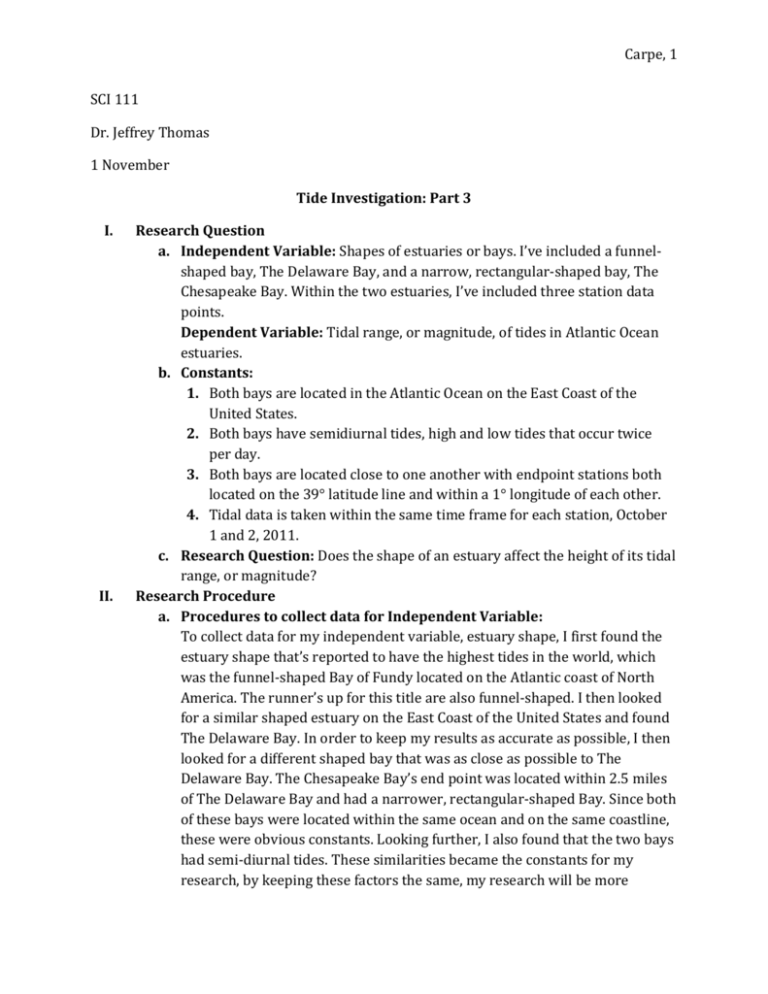
Carpe, 1 SCI 111 Dr. Jeffrey Thomas 1 November Tide Investigation: Part 3 I. II. Research Question a. Independent Variable: Shapes of estuaries or bays. I’ve included a funnelshaped bay, The Delaware Bay, and a narrow, rectangular-shaped bay, The Chesapeake Bay. Within the two estuaries, I’ve included three station data points. Dependent Variable: Tidal range, or magnitude, of tides in Atlantic Ocean estuaries. b. Constants: 1. Both bays are located in the Atlantic Ocean on the East Coast of the United States. 2. Both bays have semidiurnal tides, high and low tides that occur twice per day. 3. Both bays are located close to one another with endpoint stations both located on the 39° latitude line and within a 1° longitude of each other. 4. Tidal data is taken within the same time frame for each station, October 1 and 2, 2011. c. Research Question: Does the shape of an estuary affect the height of its tidal range, or magnitude? Research Procedure a. Procedures to collect data for Independent Variable: To collect data for my independent variable, estuary shape, I first found the estuary shape that’s reported to have the highest tides in the world, which was the funnel-shaped Bay of Fundy located on the Atlantic coast of North America. The runner’s up for this title are also funnel-shaped. I then looked for a similar shaped estuary on the East Coast of the United States and found The Delaware Bay. In order to keep my results as accurate as possible, I then looked for a different shaped bay that was as close as possible to The Delaware Bay. The Chesapeake Bay’s end point was located within 2.5 miles of The Delaware Bay and had a narrower, rectangular-shaped Bay. Since both of these bays were located within the same ocean and on the same coastline, these were obvious constants. Looking further, I also found that the two bays had semi-diurnal tides. These similarities became the constants for my research, by keeping these factors the same, my research will be more Carpe, 2 accurate since the more similar my variables actually are aside from their shape, the less room there is for incorrectly interpreting my data. b. Procedures to collect data for Dependent Variable To collect data for my dependent variable, tidal range of tides in Atlantic Ocean estuaries, I first found three stations within The Delaware Bay to analyze. I chose Lewes station at the opening, Ship John Shoal station in the middle, and Reedy Point station at the funnel’s tip. Similarly, I chose three stations within the Chesapeake Bay to analyze. I chose Kiptopeke station at the opening, Bishop’s Head station in the middle, and Tolchester Beach station which is the last station in the main estuary before breaking off into smaller estuaries. The Tolchester Beach station of Chesapeake Bay and the Reedy Point station of The Delaware Bay are located on the 39° latitude line and within a 1° longitude of each other. c. Procedures to analyze data In order to determine whether or not the shape of an estuary affects tidal range, I will first compare the overall highs and lows over a two-day period for each estuary. From this initial comparison, I will be able to determine which of the two estuaries has the overall highest and lowest tidal ranges, as well as which estuary has the greatest range between high and low tides. I will also find the average tidal ranges for each estuary in order to form a better comparison between the two by comparing the highest and lowest ranges points of each estuary. After that, I will compare the tidal ranges of the three station points within each estuary. Each estuary included a station point at the beginning, middle and end of the estuary, by comparing the similar station points against one another I will be able to determine if the tides are increasing or decreasing the further into the estuaries. For instance, since Reedy Point of The Delaware Bay and Tolchester Beach of Chesapeake Bay are both located in the most inner, endpoint, positions, I will compare them against each other to see which on average has the higher tidal ranges. This will help determine if shape does indeed affect tidal ranges. I’ll then subtract the lower tidal ranges from the higher tidal ranges in order to establish the difference between the two estuary shapes. Since I tried to keep as many variables constant as possible, differences in tidal magnitude/range can be attributed, at least in part, to the estuary’s different shapes. Carpe, 3 III. Data and Evidence a. Pictures and data Chesapeake Bay Data: Carpe, 4 A. Data: 10/01 Highest Point Lowest Point B. Data: 10/02 Highest Point Lowest Point C. Data: 10/01- 10 /02 Highest Point Lowest Point 4.2 (11:00) Kiptopeke .4 (6:00) Kiptopeke Difference between highest and lowest tides: 4.2-.4= 3.8 3.6 (13:00) Kiptopeke .3 (18:00) Tolchester Beach Difference between highest and lowest tides: 3.6-.3= 3.3 4.2 .3 (10/01, 11:00) Kiptopeke (10/02, 18:00) Tolchester Beach Difference between highest and lowest tides: 4.2-.3= 3.9 D. Average Tidal Ranges (10/01-10/02) Highest Point Lowest Point Difference Kiptopeke 4.2 .4 3.8 Bishop’s Head 2.7 .5 2.2 Tolchester Beach 2.4 .3 2.1 Average Tidal Range: (3.8+2.2+2.1)/3= 2.7 Carpe, 5 The Delaware Bay Data Carpe, 6 E. Data: 10/01 Highest Point Lowest Point F. Data: 10/02 Highest Point Lowest Point G. Data: 10/01- 10 /02 Highest Point Lowest Point 7.6 .4 (13:00) Ship John Shoal (21:00) Ship John Shoal (10:00) Reedy Point Difference between highest and lowest tides: 7.6-.4= 7.2 7.4 (14:00) Ship John Shoal .4 (21:00) Ship John Shoal Difference between highest and lowest tides: 7.4-.4=7.0 7.6 (10/01, 13:00) Ship John Shoal .4 (10/01, 21:00; 10/02, 21:00) Ship John Shoal (10/01, 10:00) Reedy Point Difference between highest and lowest tides: 7.6-.4=7.2 H. Average Tidal Ranges (10/01-10/02) Highest Point Lowest Point Difference Lewes 6.1 .6 5.5 Ship John Shoal 7.6 .4 7.2 Reedy Point 7.0 .4 6.6 Average Tidal Range: (5.5+7.2+6.6)/3=6.43 Carpe, 7 b. Analyze and describe data Judging from the above data and before breaking it down further, it’s obvious that all three of the stations located within The Delaware Bay, the funnelshapes estuary, have an overall higher water tidal range/magnitude than all three of the stations located within Chesapeake Bay, the rectangular-shaped estuary. The Delaware Bay also has a more regular rise and fall pattern as well as overlap between its low points, suggesting that funnel-shaped estuaries are also more regular in tidal patterns than rectangular-shaped estuaries. Looking closer, we can see that the highest tides for the Chesapeake Bay occurred at its station closest to the ocean, its source, while the highest tides for The Delaware Bay occurred at the estuary’s midpoint station, Ship John Shoal. This suggests that although the funnel-shaped tip was not the highest point of The Delaware Bay estuary that the shape of the estuary does promote higher water levels as you go further into the estuary. Although the estuary’s endpoint station, Reedy Point, had a lower tidal range than it’s midpoint station, Reedy Point’s tidal range was still 1.1 higher than the estuary’s source station, Lewes. This provides further evidence that funnel-shaped estuaries promote higher tidal ranges since they’re forcing large amounts of water from their wider opening, into smaller spaces at their middle and endpoints. From this data, we can also see that Chesapeake Bay’s average tidal ranges over a two-day period are almost three times lower than the average tidal ranges of The Delaware Bay (2.7 versus 6.43). While the two estuary’s source stations have only a 1.9 difference between their highest points (6.1-4.2), they’re endpoint stations have a difference of 4.6 between their highest points (7.0-2.4), further suggesting that the rectangular-shape of the Chesapeake Bay is not as conducive to producing higher tidal ranges as compared to the funnel-shape of The Delaware Bay. Looking at the data tables D and H, we can also see that while Chesapeake Bay stations tidal ranges continue to become lower as you move further into the estuary, the same is not true for The Delaware Bay. As previously noted, although the middle station has the highest ranges, the endpoint station’s range is still 1.1 higher than the source station. Overall, from analyzing the above data, we can come to the conclusion that a funnel-shaped bay produces greater tidal ranges and higher water levels when compared to those of a rectangularshaped estuary. Carpe, 8 IV. Conclusions a. Response to research question Yes, the shape of an estuary appears to have an effect on the tidal range within an estuary. More specifically, funnel-shaped estuaries appear to help create higher tidal ranges and water levels overall when compared to rectangular-shaped estuaries. They create a more significant difference between high and low tides, promote heightening water levels and tidal ranges the further you go into the estuary, and also appear to create more regular tidal patterns than rectangular-shaped estuaries. b. What factors might explain your conclusion? Because funnel-shaped estuaries gradually force large amounts of ocean water into an area that becomes increasingly narrow, the tidal ranges in these estuaries are higher than those of rectangular-shaped estuaries on average. Since rectangular-shaped estuaries maintain a more fixed shape throughout, from source point to endpoint, there is a more even disbursement of water throughout the estuary which appears to be greater at the source and gradually taper off the further you go into the estuary. Therefore, if the source point of an estuary is much larger than it’s endpoint, as in a funnel, then the tidal ranges of that estuary will be greater. c. What variables did you overlook and how could this have affected the results? 1. Estuary Depth: Prior to comparing the two estuaries against one another, I failed to determine the initial depth of both estuaries. Since ocean depth can affect tidal ranges by allowing more space for water to go, this could have greatly affected my results if one estuary was significantly shallower or deeper than the other. To refine my data, in the future, this is a variable that should be taken into consideration. By comparing estuaries with similar water depths, I would be adding another constant into my experiment; therefore my results would be more accurate. 2. Effects of Islands in Estuaries: Chesapeake Bay had significantly more small islands and bodies of land within it than The Delaware Bay did. Since the tidal ranges of Chesapeake Bay were significantly lower than those of The Delaware Bay, it would be important to find out if these bodies of land potentially block out or reduce tidal ranges by acting as barriers, or if they could potentially have some other affect that could reduce tidal ranges within an estuary. By comparing two different shaped estuaries without islands with two different shaped estuaries without islands, I could get a better idea of this variable does play a role Carpe, 9 in the differences between The Delaware Bay and Chesapeake Bay and would therefore get more accurate results.

